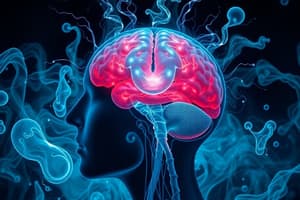Podcast
Questions and Answers
Where do local anesthetics act on the neuronal membrane?
Where do local anesthetics act on the neuronal membrane?
- On the outside of the neuronal membrane
- On the inside of the neuronal membrane (correct)
- Nowhere on the neuronal membrane
- On both the inside and outside of the neuronal membrane
What happens when a local anesthetic binds to the sodium channel?
What happens when a local anesthetic binds to the sodium channel?
- The neuronal membrane depolarizes
- The action potential is generated
- The flow of sodium ions is blocked (correct)
- The neuronal membrane hyperpolarizes
What is the primary mechanism of action of local anesthetics?
What is the primary mechanism of action of local anesthetics?
- Increasing the transmission of nerve impulses
- Blocking the transmission of nerve impulses (correct)
- Changing the pH of the tissue
- Binding to proteins
Where do local anesthetics primarily act to block the transmission of pain signals?
Where do local anesthetics primarily act to block the transmission of pain signals?
What type of local anesthetic acts on the sodium channel from the outside of the neuronal membrane?
What type of local anesthetic acts on the sodium channel from the outside of the neuronal membrane?
What factor can affect the binding of local anesthetics to the sodium channel?
What factor can affect the binding of local anesthetics to the sodium channel?
What happens to the action potential when a local anesthetic binds to the sodium channel?
What happens to the action potential when a local anesthetic binds to the sodium channel?
What is the result of a higher concentration of local anesthetic?
What is the result of a higher concentration of local anesthetic?
Flashcards are hidden until you start studying
Study Notes
Local Anesthesia Mechanism of Action
Overview
Local anesthesia works by blocking the transmission of nerve impulses, preventing the sensation of pain.
Mechanism of Action
Local anesthetics act on the neuronal membrane, specifically the voltage-gated sodium channels.
- Binding to the sodium channel: The local anesthetic molecule binds to the sodium channel, blocking the flow of sodium ions.
- Depolarization: The binding of the local anesthetic prevents the neuronal membrane from depolarizing, which is necessary for the transmission of nerve impulses.
- Inhibition of action potential: The blocked sodium channels inhibit the generation of action potentials, preventing the transmission of pain signals.
Types of Local Anesthetics
- Amides (e.g., lidocaine, mepivacaine): Act on the sodium channel from the inside of the neuronal membrane.
- Esters (e.g., tetracaine, benzocaine): Act on the sodium channel from the outside of the neuronal membrane.
Site of Action
- Terminal nerve endings: Local anesthetics act on the terminal nerve endings, where the nerve impulses are generated.
- Dorsal root ganglion: Some local anesthetics may also act on the dorsal root ganglion, where the nerve impulses are transmitted to the spinal cord.
Factors Affecting Local Anesthesia
- Concentration: Higher concentrations of local anesthetics increase the binding to the sodium channel, leading to more effective anesthesia.
- pH: The pH of the tissue can affect the binding of the local anesthetic to the sodium channel.
- Protein binding: The binding of local anesthetics to proteins can affect their availability and efficacy.
Local Anesthesia Mechanism of Action
- Local anesthesia works by blocking the transmission of nerve impulses, preventing the sensation of pain.
Mechanism of Action
- Local anesthetics act on the neuronal membrane, specifically the voltage-gated sodium channels.
- The local anesthetic molecule binds to the sodium channel, blocking the flow of sodium ions.
- This binding prevents the neuronal membrane from depolarizing, which is necessary for the transmission of nerve impulses.
- The blocked sodium channels inhibit the generation of action potentials, preventing the transmission of pain signals.
Types of Local Anesthetics
- Amides (e.g., lidocaine, mepivacaine) act on the sodium channel from the inside of the neuronal membrane.
- Esters (e.g., tetracaine, benzocaine) act on the sodium channel from the outside of the neuronal membrane.
Site of Action
- Local anesthetics act on the terminal nerve endings, where the nerve impulses are generated.
- Some local anesthetics may also act on the dorsal root ganglion, where the nerve impulses are transmitted to the spinal cord.
Factors Affecting Local Anesthesia
- Higher concentrations of local anesthetics increase the binding to the sodium channel, leading to more effective anesthesia.
- The pH of the tissue can affect the binding of the local anesthetic to the sodium channel.
- The binding of local anesthetics to proteins can affect their availability and efficacy.
Studying That Suits You
Use AI to generate personalized quizzes and flashcards to suit your learning preferences.




